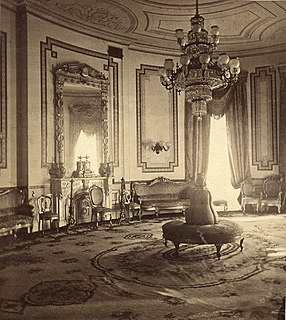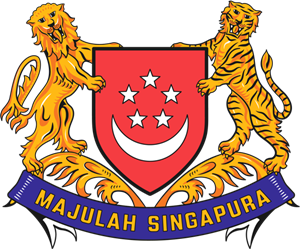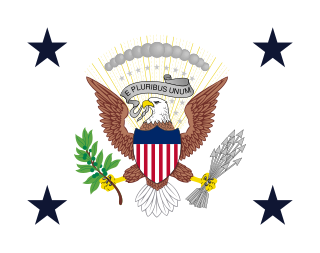
A flag is a piece of fabric with a distinctive design and colours. It is used as a symbol, a signalling device, or for decoration. The term flag is also used to refer to the graphic design employed, and flags have evolved into a general tool for rudimentary signalling and identification, especially in environments where communication is challenging. The study of flags is known as "vexillology" from the Latin vexillum, meaning "flag" or "banner".

Pottery is the process and the products of forming vessels and other objects with clay and other ceramic materials, which are fired at high temperatures to give them a hard and durable form. Major types include earthenware, stoneware and porcelain. The place where such wares are made by a potter is also called a pottery. The definition of pottery, used by the ASTM International, is "all fired ceramic wares that contain clay when formed, except technical, structural, and refractory products." In art history and archaeology, especially of ancient and prehistoric periods, "pottery" often means vessels only, and sculpted figurines of the same material are called "terracottas".

Émile Gallé was a French artist and designer who worked in glass, and is considered to be one of the major innovators in the French Art Nouveau movement. He was noted for his designs of Art Nouveau glass art and Art Nouveau furniture, and was a founder of the École de Nancy or Nancy School, a movement of design in the city of Nancy, France.

Faience or faïence is the general English language term for fine tin-glazed pottery. The invention of a white pottery glaze suitable for painted decoration, by the addition of an oxide of tin to the slip of a lead glaze, was a major advance in the history of pottery. The invention seems to have been made in Iran or the Middle East before the ninth century. A kiln capable of producing temperatures exceeding 1,000 °C (1,830 °F) was required to achieve this result, the result of millennia of refined pottery-making traditions. The term is now used for a wide variety of pottery from several parts of the world, including many types of European painted wares, often produced as cheaper versions of porcelain styles.

A greeting card is a piece of card stock, usually with an illustration or photo, made of high quality paper featuring an expression of friendship or other sentiment. Although greeting cards are usually given on special occasions such as birthdays, Christmas or other holidays, such as Halloween, they are also sent to convey thanks or express other feelings.

Chintz is a woodblock printed, painted, stained or glazed calico textile that originated in Golconda in the 16th century. The cloth is printed with designs featuring flowers and other patterns in different colours, typically on a light, plain background.

Textile manufacturing is a major industry. It is largely based on the conversion of fibre into yarn, then yarn into fabric. These are then dyed or printed, fabricated into cloth which is then converted into useful goods such as clothing, household items, upholstery and various industrial products. Overall, many things can be made with cotton, not just clothing.

The Blue Room is one of three state parlors on the first floor in the White House, the residence of the president of the United States. It is distinct for its oval shape. The room is used for receptions and receiving lines and is occasionally set for small dinners. President Grover Cleveland married Frances Folsom in the room on June 2, 1886, the only wedding of a President and First Lady in the White House. The room is traditionally decorated in shades of blue. With the Yellow Oval Room above it and the Diplomatic Reception Room below it, the Blue Room is one of three oval rooms in James Hoban's original design for the White House.
The manufacture of textiles is one of the oldest of human technologies. To make textiles, the first requirement is a source of fiber from which a yarn can be made, primarily by spinning. The yarn is processed by knitting or weaving, which turns yarn into cloth. The machine used for weaving is the loom. For decoration, the process of colouring yarn or the finished material is dyeing. For more information of the various steps, see textile manufacturing.

The Coat of arms of Singapore is the heraldic symbol representing the Southeast Asian island nation of Singapore. It was adopted in 1959, the year Singapore became self-governing within the British Empire. The committee that created it, headed by then Deputy Prime Minister Toh Chin Chye, was also responsible for the national flag and the national anthem of Singapore.
National symbols of Singapore are the symbols that are used in Singapore to represent what is unique about the nation, reflecting different aspects of its cultural life and history.

The flag of the vice president of the United States consists of the U.S. vice presidential coat of arms on a white background, with four dark blue stars in the corners. A version of the flag is kept in the vice president's office, is sometimes displayed by the vice president in official photos, and is flown on the vice president's motorcade.
Mockado is a woollen pile fabric made in imitation of silk velvet from the mid-sixteenth century. Mockado was usually constructed with a woollen pile on a linen or worsted wool warp and woollen weft, although the ground fabric could be any combination of wool, linen, and silk. Mockado was used for furnishings and carpeting, and also for clothing such as doublets, farthingales, and kirtles.
Annin Flagmakers is an American corporation based in Roseland, New Jersey. The flagmaker was founded by Alexander Annin in 1847 and incorporated on January 10, 1910. Annin Flagmakers produces American flags, state flags and national flags of all United Nations members. Annin is a wholesaler that sells through a network of independent dealers and through mass market retailing chains. Annin is a private company owned by the Beard and Dennis families. While sales are not reported, industry estimates are between 75 million and 100 million dollars annually for Annin & Co.

China painting, or porcelain painting, is the decoration of glazed porcelain objects such as plates, bowls, vases or statues. The body of the object may be hard-paste porcelain, developed in China in the 7th or 8th century, or soft-paste porcelain, developed in 18th-century Europe. The broader term ceramic painting includes painted decoration on lead-glazed earthenware such as creamware or tin-glazed pottery such as maiolica or faience.
The basic chronology of the early town of Manda Island in the Lamu Archipelago of Kenya is divided into 6 different periods, based mostly on the types of imported pottery that has been found in different strata of the excavations. The first period, I, begins in the mid ninth century and is subdivided into four parts, a, b, c, and d, ending in the early eleventh century. Period II has two parts, A and B, though the divide between the two is rather vague and could be entirely arbitrary, and dates from the mid eleventh to the late twelfth for the former, and late twelfth to late thirteenth century for the latter. Period III runs from the late thirteenth century to the fourteenth when Period IV picks up and ends in the early Sixteenth. Period V covers the mid Sixteenth and all of the seventeenth, and the final period covers everything after the Seventeenth century.
Calamanco is fabric with a glazed surface that was popular in Europe and the United States in the 18th and 19th centuries. It was typically made of worsted-spun wool yarn, and the glazing was achieved by calendaring, by surface-rubbing with a stone, or by applying wax to the surface. The name comes from a Spanish term for worsted wool.

Surrey whiteware or Surrey white ware, is a type of lead-glazed pottery produced in Britain from the 13th to the 16th centuries. The white-fired sandy earthenware was produced largely from kilns in Surrey and along the Surrey-Hampshire border. Surrey whitewares were the most commonly used pottery in London during the late medieval period. There are four classes of Surrey whiteware: Kingston-type, Coarse Border ware, Cheam whiteware and Tudor Green ware.
Bed hangings or bed curtains are fabric panels that surround a bed; they were used from medieval times through to the 19th century. Bed hangings provided privacy when the master or great bed was in a public room, such as the parlor. They also kept warmth in, and were a way of showing one's wealth. When bedrooms became more common in the mid-1700s, the use of bed hangings diminished.
Durant was a glazed woolen material of the 18th century. Durant was hot-pressed with a fold in the middle, leaving a crease in the fabric. Durant was manufactured in England.



















